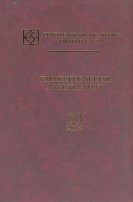Eesti verbimorfoloogia esimestest kirjeldustest
First descriptions of Estonian verb morphology
Author(s): Annika KilgiSubject(s): Language and Literature Studies
Published by: Teaduste Akadeemia Kirjastus
Keywords: morphology; conjugations; history of written Estonian
Summary/Abstract: The period between the 17th and 19th centuries witnessed the publication of about twenty grammars and textbooks of the Estonian language. They vary greatly in length, depth, and innovation, but in general there is development towards more accurate and modern description. Verb morphology in the first handbooks was influenced by the framework of traditional Latin grammar and contemporary German grammars. The description of areas corresponding to German morphology has remained virtually unchanged until today (indicative, conditional, imperative; present, imperfect, perfect, pluperfect). In the beginning, the Indo-European personal passive was used instead of the Estonian impersonal, and the Indo-European subjunctive was used instead of the Estonian quotative. The saama-future was regarded as a tense both in the first grammars and in grammars published at the end of the 19th century. The grammarians also thought that Estonian has no morphological future. The interpretation of non-finite forms has been extremely diverse. However, some opinions of the grammarians of the 19th century are still found in contemporary Estonian grammars. For example, the v- and tav-forms are regarded present participles and the tud- and nud-forms are as past participles; mas-, mast- and mata-forms are treated as cases of the ma-infinitive. Grammarians realized already at the end of the 17th century that not all Estonian verbs follow identical conjugation patterns. Therefore, they listed word types that differed most from the main paradigm of verbs with the unchanging stem. In the 19th century several attempts were made to divide all Estonian verbs into conjugations. As each grammarian applied the phonological criteria (e.g. structure of the ma-infinitive) for determining his conjugations differently, the results were also different. The appearance of an Estonian word does not always reliably predict its morphological type, therefore each of the proposed conjugation systems included some clases that contained verbs with differences in conjugation.
Journal: Emakeele Seltsi aastaraamat
- Issue Year: 2004
- Issue No: 50
- Page Range: 175-197
- Page Count: 22
- Language: Estonian

